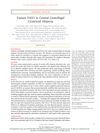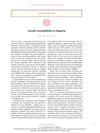Deciphering the Pathogenesis of Central Centrifugal Cicatricial Alopecia
September 2019
TLDR Mutations in the PADI3 gene may cause central centrifugal cicatricial alopecia in women of African ancestry.
Central centrifugal cicatricial alopecia (CCCA) was identified as the most common form of scarring alopecia among women of African ancestry, with a prevalence of 2.7%-5.6%. The study aimed to identify genetic risk variants for CCCA and used whole exome sequencing on 16 patients, discovering one splice site and three heterozygous missense mutations in the PADI3 gene. PADI3 encodes an enzyme crucial for hair-shaft formation, and the mutations were predicted to be pathogenic, leading to protein misfolding, reduced expression, abnormal localization, and decreased enzymatic activity. In a replication set of 42 patients, pathogenic variants were found in 24% of CCCA patients, suggesting that mutations in PADI3 may contribute to the development of CCCA.



